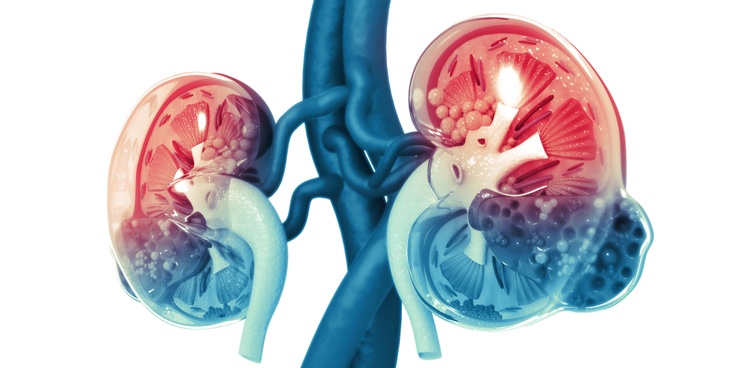Acute Kidney Injury from Acute Tubular Necrosis vs Prerenal Cause–How Do I Tell the Difference?

In the hospital setting, 65-75% of AKI is caused by one of two etiologies: prerenal causes and acute tubular necrosis (ATN).
What is a “prerenal” condition?
Prerenal conditions are characterized by a diminished blood flow into the kidneys. Prerenal conditions typically are reversible; they usually do not cause permanent kidney damage unless compromised renal perfusion is sustained and/or severe. Causes include:
- Low cardiac output from:
- Hypovolemia: dehydration, hemorrhage, or renal (diuretics) or gastrointestinal (vomiting, diarrhea) fluid loss
- Cardiovascular disease (heart failure, cardiogenic shock, aortic stenosis)
- Hypotension: decreased blood pressure can result from shock (hypovolemic, myocardial, or septic) and aggressive treatment of severe hypertension
- Venous pooling in abdominal organs and systemic vasodilation in cirrhosis
- Drugs: angiotensin-converting enzyme inhibitors or angiotensin II blockers, NSAIDS, etc.
When a normal kidney is exposed to hypoperfusion it responds by trying to increase circulating fluid volume. Kidneys enhance reabsorption of sodium and water, resulting in oliguria (urine output <500 mL/day) with high urine osmolality and low urine sodium. Consider what happens when you do not drink sufficient fluid–you urinate less, and any urine voided is more concentrated (higher osmolality). Your kidneys pull water and sodium back out of the urine to preserve blood fluid volume. Additionally, your thirst mechanism is stimulated. All of these serve to promote a sufficient intravascular fluid volume.
What is acute tubular necrosis?
ATN is the most common cause of AKI in hospitalized adults. Like its prerenal counterpart, it is usually reversible, but resolves much more slowly. ATN is usually seen in patients who demonstrate one of 3 temporally related events leading to the onset of AKI:
- Renal hypoperfusion: can result from any cause of severe prerenal disease, particularly if accompanied by hypotension, surgery, and/or sepsis. Oddly, heart failure rarely leads to ATN
- Sepsis: may induce any prolonged prerenal mechanism or cause release of cytokines and activation of neutrophils by cytokines
- Nephrotoxin exposure– common nephrotoxins include:
- Aminoglycosides
- Amphotericin B
- Chemotherapy drugs like cisplatin
- Iodinated radiocontrast media
- Nonsteroidal anti-inflammatory drugs (NSAIDs; especially when concurrent with poor renal perfusion or other nephrotoxic agents)
- Calcineurin inhibitors like tacrolimus and cyclosporine
- Vancomycin (particularly with supratherapeutic dosing or when combined with piperacillin-tazobactam)
- Heme pigments:
- trauma, seizures or rhabdomyolysis-induced myoglobin release from muscles
- hemolysis-induced hemoglobin release
- both myoglobin and hemoglobin are filtered by the kidney, causing the release of heme pigment
Acute tubular necrosis causes injury to the renal tubular cells, resulting in sloughing of cells into the lumen. One mechanism leading to AKI is the obstruction of tubules by these sloughed cells. These cells are involved in helping regulate reabsorption of water and sodium (Na) out of the urine back into the bloodstream; in ATN, kidneys tend to lose water and sodium, making urine Na content higher and urine osmolality lower than that seen in prerenal AKI alone.
How is AKI due to ATN differentiated from prerenal AKI?
The distinction is typically made by the response to volume expansion, as well as by urine and serum chemistry labs and calculations derived from them (e.g., fractional excretion of sodium [FeNa]).
Because of the sloughed cells, it takes time for the tubular cells to regenerate. Mild ATN will take over 72 hours (>3 days) to recover, and more severe cases often will take weeks. If a patient has AKI that recovers quickly (in less than 3 days), it is unlikely to be ATN. In such cases, prerenal or postrenal (obstructive etiologies involving ureter, bladder, prostate, or urethra) causes are more likely.
Commonly encountered studies performed to distinguish prerenal AKI from ATN-induced AKI
| Test* | Prerenal AKI | ATN |
| BUN/Cr ratio | >20:1 | 10-15:1 |
| FeNa (%) | <1% (FeUrea is more reliable in patients on diuretics (<35% in prerenal AKI) | >2% (but can be low in early ATN, contrast or pigment induced ATN) |
| Urine Na (mEq/L) | <20 | >40 |
| Urine Osmolality (mOsm/L or mmol/L) | >500 | <450 (usually <350) |
| UA and Microscopy | Specific gravity (SG) >1.020, normal or with hyaline casts | SG~1.010, granular casts (rarely, “muddy brown”), tubular epithelial casts |
*Tests are less reliable in patients on diuretics or with chronic kidney disease
Coding issues:
Question: If a patient is admitted with hypovolemic shock due to volume depletion or dehydration and associated AKI (or ATN), what is the proper way to sequence these diagnoses?
Answer: Sequence either volume depletion/dehydration or AKI/ATN as PDX with hypovolemic shock as ODX
Question: A patient with pre-existing CKD stage 3 (baseline SCr 1.8 mg/dL) is admitted with AKI (SCr 2.9) . Serial serum creatinine values are followed. With IV fluid replacement and avoidance of nephrotoxins the SCr improved over the next 48 hours to patient’s baseline of 1.8 mg/dL. AKI was documented to be from ATN. Can N17.0 code for ATN be designated as POA (Y)?
Answer: A 3rd Quarter 2020 Coding Clinic addresses a very similar scenario. The advice provided is to assign N17.0 with POA indicator of “Y” as it confers greater specificity for the AKI.
However, given the rapid resolution of the AKI (within 48 hours) it is likely the ATN could be challenged on a clinical basis. ATN-induced AKI usually requires more than 72 hours to resolve. It is advisable to query or escalate this to your physician advisor.
References:
UpToDate: Etiology and diagnosis of prerenal disease and acute tubular necrosis in acute kidney injury in adults, May 2020
Merck Manual Professional Version: Acute Tubular Necrosis (ATN), June 2020
The ICU Book, 3rd Ed. Marino, PL Chapter 31, page 581. Lippincott Williams &Wilkins, 2007
Coding Clinic for ICD-10-CM/PCS, Third Quarter 2020: Page 22